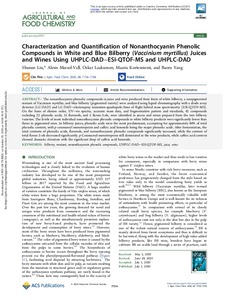Characterization and Quantification of Nonanthocyanin Phenolic Compounds in White and Blue Bilberry (Vaccinium myrtillus) Juices and Wines Using UHPLC-DAD−ESI-QTOF-MS and UHPLC-DAD
Shuxun Liu; Alexis Marsol-Vall; Oskar Laaksonen; Maaria Kortesniemi; Baoru Yang
https://urn.fi/URN:NBN:fi-fe2021042823079
Tiivistelmä
The nonanthocyanin phenolic compounds in juice and wine produced from fruits of white bilberry, a nonpigmented mutant of Vaccinium myrtillus, and blue bilberry (pigmented variety) were analyzed using liquid chromatography with a diode array detector (LC-DAD) and LC-DAD−electrospray ionization-quadrapole/time of flight hybrid mass spectrometry (ESI-QTOF-MS). On the basis of elution order, UV−vis spectra, accurate mass data, and fragmentation pattern and standards, 42 compounds including 22 phenolic acids, 15 flavonols, and 5 flavan-3-ols, were identified in juices and wines prepared from the two bilberry varieties. The levels of most individual nonanthocyanin phenolic compounds in white bilberry products were significantly lower than those in pigmented ones. In bilberry juices, phenolic acids were the most predominant, accounting for approximately 80% of total phenolic content, with p-coumaroyl monotropeins and caffeic acid hexoside being the major phenolic acids. After fermentation, the total contents of phenolic acids, flavonols, and nonanthocyanin phenolic compounds significantly increased, while the content of total flavan-3-ols decreased significantly. p-Coumaroyl monotropeins still dominated in the wine products, while caffeic acid content showed dramatic elevation with the significant drop of caffeic acid hexoside.
Kokoelmat
- Rinnakkaistallenteet [27094]
